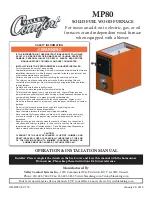
14
!
WARNING:
Furnace installation using methods
other than those described in the fol-
lowing sections must comply with the
National Fuel Gas Code and all appli-
cable local codes to provide sufficient
combustion air for the furnace.
Combustion Air Quality
The recommended source of combustion air is
to use the outdoor air supply. However, the use
of indoor air in most applications is acceptable
except as follows:
1.
If the furnace is installed in a confined space
it is recommended that the necessary com-
bustion air come from the outdoors by way
of attic, crawl space, air duct, or direct
opening.
2.
If outdoor combustion air is used, there
must be no exposure to the installations or
substances listed in Item 3 below.
3.
The following types of installation may re-
quire
Outdoor Air
for combustion, due to
chemical exposures:
• Commercial buildings
• Buildings with indoor pools
• Furnaces installed in laundry rooms
• Furnaces installed in hobby or craft rooms
• Furnaces installed near chemical stor-
age areas
Exposure to the following substances in the
combustion air supply may also require
Outdoor Air
for combustion:
• Permanent wave solutions
• Chlorinated waxes and cleaners
• Chlorine based swimming pool chemi-
cals
• Water softening chemicals
• De-icing salts or chemicals
• Carbon tetrachloride
• Halogen type refrigerants
• Cleaning solvents (such as perchloroet-
hylene)
• Printing inks, paint removers, varnishes,
etc.
• Hydrochloric acid
• Cements and glues
• Antistatic fabric softeners for clothes dry-
ers
• Masonry acid washing materials
Air Requirements For One-Pipe
Installation
When air for combustion is to be taken from
around the furnace, a protective screen must be
installed over the combustion air intake opening.
This screen is provided with the furnace instal-
lation instructions and functions to prevent de-
bris from entering the combustion system. It
should be installed on the combustion air intake
collar or inlet PVC. If furnace location is such that
this opening might be unintentionally obstructed,
a 3" PVC elbow should be installed on the collar,
and the screen placed inside the inlet of the
elbow. See Figure 10.
Installation In An Unconfined Space
!
CAUTION:
"Tight" buildings (with weather strip-
ping and caulk to reduce infiltration),
may require special provisions for in-
troduction of outside air to ensure
satisfactory combustion and venting,
even though the furnace is located in
an unconfined space.
An unconfined space is an area including all
rooms not separated by doors with a volume
greater than 50 cubic feet per 1,000 Btuh of the
combined input rates of all appliances which draw
combustion air from that space. For example, a
space including a water heater rated at 45,000
Btuh and a furnace rated at 75,000 Btuh requires
a volume of 6,000 cubic feet [50 x (45 + 75) =
6,000] to be considered unconfined. If the space
has an 8 foot ceiling, the floor area of the space
must be 750 square feet (6,000 / 8 = 750). In
general, a furnace installed in an unconfined
space will not require outside air for combustion.
!
WARNING:
Furnaces installed with combustion air
drawn from a heated space which in-
cludes exhaust fans, fireplaces, or
other devices that may produce a nega-
tive pressure should be considered
confined space installations.
Installation In A Confined Space
A confined space is one which does not meet the
unconfined space volume requirements, and
Summary of Contents for TC060
Page 2: ...2 ...















































